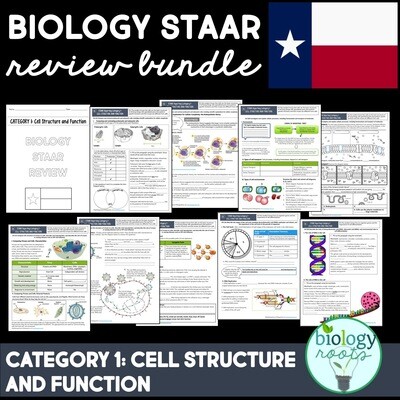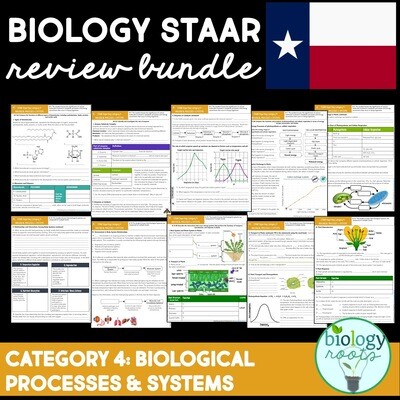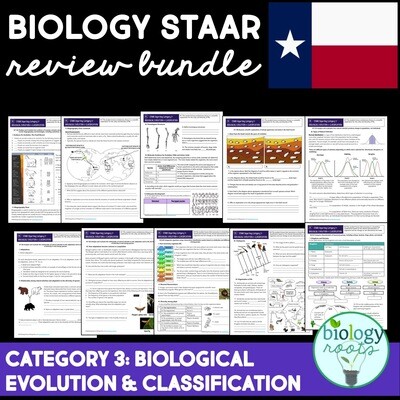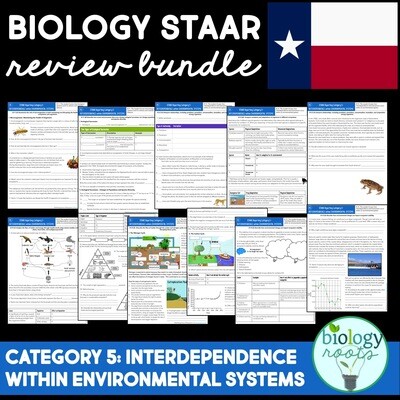
Categories
STAAR Biology Review BUNDLE
$36.99
Product Details
This review tool for the STAAR EOC Biology exam (State of Texas Assessment of Academic Readiness) covers all readiness and supporting TEKS for Bio 5 - Bio 13.
Bio 5 and Bio 6: Structures, Functions, and Processes: Biomolecules; cells and cell division; homeostasis
TEKS Bio 5 included and clearly outlined:
- 2 pages- Bio 5 (A)- Relate the functions of different types of biomolecules, including carbohydrates, lipids, proteins, and nucleic acids, to the structure and function of a cell
- 2 pages- Bio 5 (B)- Compare and contrast prokaryotic and eukaryotic cells, including their complexity, and compare and contrast scientific explanations for cellular complexity.
- 2 pages- Bio 5 (C)- Investigate homeostasis through the cellular transport of molecules.
- 3 pages- Bio 5 (D)- Compare the structure of viruses to cells and explain how viruses spread and cause disease.
TEKS Bio 6 included and clearly outlined:
- 2 pages- Bio 6 (A) Explain the importance of the cell cycle to the growth of organisms, including an overview of the stages of the cell cycle and deoxyribonucleic acid (DNA) replication models.
- 2 pages- Bio 6 (B)- Explain the process of cell specialization through cell differentiation, including the role of environmental factors
- 2 pages- Bio 6 (C)- Relate disruptions of the cell cycle to how they lead to the development of diseases such as cancer
TEKS Bio 7 included and clearly outlined:
- 2 pages- B.7 (A) Identify components of DNA, identify how the nucleotide sequence specifies some traits of an organism, and examine scientific explanations for the origin of DNA.
- 4 pages- B.7 (B) Describe the significance of gene expression and explain the process of protein synthesis using models of DNA and RNA.
- 2 pages- B.7 (C) Identify and illustrate changes in DNA and evaluate the significance of these changes
- 1 pages- B.7 (D)- Discuss the importance of molecular technologies such as polymerase chain reaction (PCR), gel electrophoresis, and genetic engineering that are applicable in current research and engineering practices.
TEKS Bio 8 included and clearly outlined:
- 2 pages- B.8 (A)- Analyze the significance of chromosome reduction, independent assortment, and crossing‐over during meiosis in increasing diversity in populations of organisms that reproduce sexually
- 2 pages- B.8 (B)- Predict possible outcomes of various genetic combinations using monohybrid and dihybrid crosses, including non‐Mendelian traits of incomplete dominance, codominance, sex‐linked traits, and multiple alleles.
TEKS B.9 included and clearly outlined:
- 3 pages- B.9 (A) Analyze and evaluate how evidence of common ancestry among groups is provided by the fossil record, biogeography, and homologies, including anatomical, molecular and development.
- 1 page- B.9 (B) Examine scientific explanations for varying rates of change such as gradualism, abrupt appearance, and stasis in the fossil record.
TEKS B.10 included and clearly outlined:
- 2 pages- B.10 (A) Analyze and evaluate how natural selection produces change in populations, not individuals
- 2 pages- B.10 (B) Analyze and evaluate how the elements of natural selection, including inherited variation, the potential to produce more offspring than can survive, and a finite supply of resources, result in differential reproductive success.
- 2 pages- B.10 (C)- Analyze and evaluate how natural selection may lead to speciation
- 1 pages- B.10 (D) Analyze evolutionary mechanisms other than natural selection, including genetic drift, gene flow, mutation, and genetic recombination, and their effect on the gene pool of a population.
Bio 11 and 12: Biological Processes and Systems (plant and animal systems)
TEKS B.11 included and clearly outlined:
- 2 pages- B.11 (A) Explain how matter is conserved and energy is transferred during photosynthesis and cellular respiration using models, including the chemical equations for these processes.
- 2 pages- B.11 (B) Investigate and explain the role of enzymes in facilitating cellular processes.
TEKS B.12 included and clearly outlined:
- 3 pages- B.10 (A) Analyze the interactions that occur among systems that perform the functions of regulation, nutrient absorption, reproduction, and defense from injury or illness in animals.
- 3 pages- B.12 (B) Explain how the interactions that occur among systems that perform functions of transport, reproduction, and response in plants are facilitated by their structure.
TEKS Bio 13 included and clearly outlined:
- 2 pages- B.13 (A) Interpret relationships, including predation, parasitism, commensalism, mutualism, and competition among organisms.
- 2 pages- B.13 (B) Analyze how ecosystem stability is affected by disruptions to the cycling of matter and flow of energy through trophic levels sing models.
- 2 pages- B.13 (C) Explain the significance of the carbon and nitrogen cycles to ecosystem stability and analyze the consequences of disrupting these cycles
- 2 pages- B.13 (D) Explain how environmental change, including change due to human activity, affects biodiversity and analyze how changes in biodiversity impact ecosystem stability.
Optional cover page to make a booklet.
Black and white versions included (coming soon).
Answer key is included.
Vanessa Jason Biology Roots
For single classroom only; not to be shared publicly (do not create publicly accessible links).
Copying for more than one teacher, classroom, department, school, or district is prohibited. Failure to comply is a violation of the DMCA (Digital Millennium Copyright Act).
☆☆Follow me on☆☆
STAAR Biology Review BUNDLE
You May Also Like





